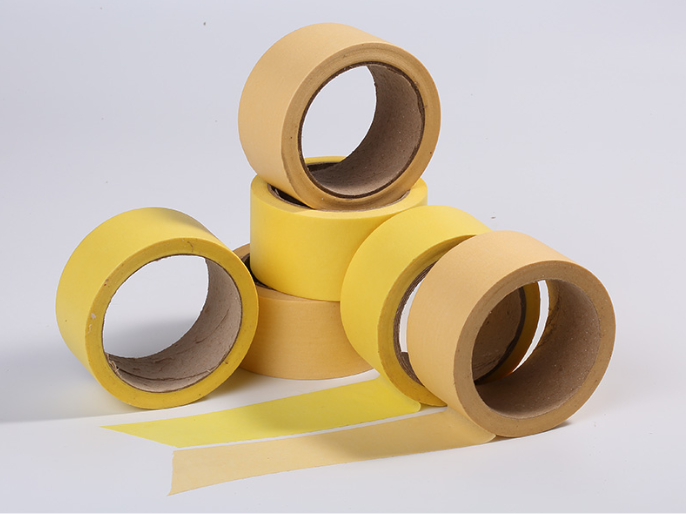May. 22, 2025
Masking tapes are essential tools in industries ranging from powder coating and automotive painting to electronics, metal finishing, and woodwork. However, one common issue that plagues operators and manufacturers alike is residue left behind after tape removal. This sticky adhesive residue not only disrupts workflow but can lead to quality issues, surface damage, and increased labor costs.
Understanding the causes, choosing the right masking tape, and implementing best practices can significantly reduce or eliminate adhesive residue. This guide dives deep into why tape residue happens, how to prevent it, and which masking tapes perform best under demanding industrial conditions.

Several factors contribute to the presence of adhesive residue after removing masking tape:
Incorrect Tape Selection
Low-quality or general-purpose tapes may not be designed to handle high temperatures, UV exposure, or chemical contact, leading to adhesive breakdown and residue.
Overexposure to Heat
In high-temperature processes such as powder coating or oven curing, tapes not rated for elevated heat can soften, bleed adhesive, or fuse to the surface.
Prolonged Application Time
Leaving masking tape on surfaces for extended periods—especially in sunlit or humid environments—can cause adhesive anchoring, making it harder to peel cleanly.
Incompatible Surface Finishes
Certain coatings, plastics, or powder-coated metals may interact negatively with the tape's adhesive, increasing the chance of residue.
Improper Removal Techniques
Fast or jerky removal at incorrect angles may cause the adhesive to separate from the tape backing and stick to the surface.
| Application | Recommended Tape Type |
|---|---|
| High-Temp Powder Coating | Silicone masking tape or polyester tape |
| UV Exposure | UV-resistant acrylic tape |
| Delicate Surfaces | Low-tack masking tape |
| Long-Term Masking | Residue-free polyimide or specialty tapes |
Key terms to look for: Clean removal, No adhesive transfer, Temperature rating, UV resistance, Chemical resistance
Each masking tape has a maximum service temperature. For example:
Standard crepe paper tape: up to 80°C
Polyester masking tape: up to 200°C
Polyimide (Kapton) tape: up to 260°C
Exceeding these limits increases the risk of adhesive softening and transfer.
As a general rule:
Short-term masking (less than 24 hours) carries minimal risk of residue.
Long-term masking (over 48–72 hours) should use specially designed tapes labeled as “clean removal after long-term use.”
Tip: Always check the tape’s dwell time performance listed in its technical datasheet.
Before applying the masking tape:
Clean the surface of dust, grease, and moisture.
Avoid using solvent cleaners that may chemically react with the adhesive.
Contaminated or oily surfaces often cause adhesive migration, increasing residue risk.
Peel the tape slowly and evenly at a 45° to 90° angle.
Remove tape immediately after processing—don’t let it cool fully if used in heat applications.
In cold environments, warm the tape slightly to improve flexibility and clean removal.
In powder coating lines, tape residue can damage finish quality or cause rejects. Use silicone masking tape or polyester masking discs that can withstand 180–220°C. Immediate removal post-curing is best practice.
Residue on circuit boards can cause conductivity issues. Use polyimide tapes with anti-static properties and clean room-rated adhesives.
Masking tapes used for multi-layer paint or corrosion protection must not leave residue on clear coats or composites. UV-resistant acrylic adhesives are typically preferred.
For natural or painted wood, low-tack painter’s tape reduces the risk of fiber lift and adhesive residue. Ensure compatibility with surface sealants or varnishes.
| Surface | Recommended Cleaning Method |
|---|---|
| Powder-Coated Metal | Isopropyl alcohol, non-abrasive cloth |
| Painted Surfaces | Mild detergent or citrus-based adhesive remover |
| Plastic or PVC | Silicone-free degreaser, avoid acetone |
| Wood | Warm water with soap, soft sponge |
| Glass or Ceramic | Razor blade scraper (carefully), followed by alcohol |
Always test on a small, hidden area before full cleaning to ensure no damage or discoloration.
Before bulk application, conduct a test run:
Apply the tape to a production sample.
Subject it to the same curing/processing conditions.
Remove and inspect for residue or surface damage.
Evaluate adhesive consistency, edge bleed, and removal quality.
Reviewing technical datasheets, MSDS, and industry certifications (RoHS, REACH, UL, etc.) also helps ensure product suitability.
| Myth | Reality |
|---|---|
| “All tapes are the same.” | Adhesives vary widely in chemistry, tack, and thermal properties. |
| “Residue is always due to tape quality.” | Often caused by surface contamination, overbake, or excessive dwell time. |
| “Low-tack tape won’t leave residue.” | Even low-tack adhesives can transfer if exposed to heat or UV for too long. |
No-residue high-temp silicone tapes
Low-VOC, eco-friendly adhesives
Anti-bleed edge tapes for sharp lines
UV-indicator tapes that change color after exposure
Custom die-cut masking solutions for complex geometries
Staying updated with the latest tape technologies ensures better production efficiency and product quality.
Tape residue is more than just a sticky inconvenience—it can delay production, compromise quality, and result in rework or product rejection. By understanding why it happens and following best practices in tape selection, surface preparation, process control, and removal technique, you can minimize this common problem across a wide range of applications.
Whether you’re in powder coating, electronics, woodworking, or precision manufacturing, a clean finish starts with choosing the right masking tape and using it properly.
NB Technology offers a full range of high-performance masking tapes designed for clean removal—even under extreme conditions. Discover residue-free solutions trusted by global manufacturers.
Navigation
+86 158 1691 5404
+86 757 8271 3937
+86 757 8271 3937
No. 10 Industry Huacongsiyue Village, Shishan Town, Nanhai District, Foshan, Guangdong Province, China